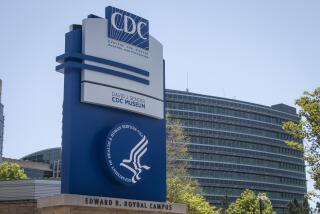U.S. Approves Welfare Cut by California
- Share via
SACRAMENTO — The Bush Administration has given California permission to implement welfare reductions, clearing the way next month for an across-the-board cut in cash benefits and restrictions on payments to new residents.
State officials said the action by the U.S. Department of Health and Human Services means that effective Dec. 1, benefits paid by the Aid to Families with Dependent Children (AFDC) program will be cut 1.3%. The effect is to reduce the maximum grant for a family of three--typically a mother and two children--from $633 to $625 a month.
At the same time, California will become one of the few states that limits the amount of welfare that can be collected by new residents. Beginning Dec. 1 all newcomers receiving AFDC will be restricted to the benefit levels of their previous home states and won’t be entitled to the California rate until they have lived here a full year.
The restrictions are designed to discourage poor families living in lower benefit states from moving to California in order to collect more welfare. Gov. Pete Wilson and some legislators contend that California’s relatively high benefits have made it a welfare magnet, although they concede they have little firm evidence to back that claim.
The new rate structure was authorized by the California Legislature during the last session as part of an effort to balance the state budget by closing an $11-billion gap between tax revenues and anticipated spending.
Many Democrats endorsed the changes, some hoping to preempt Wilson’s proposed initiative that would have made even steeper cuts in welfare benefits. The Democrats’ strategy is believed to have helped defeat the initiative, Proposition 165, in the Nov. 3 election.
Because AFDC is paid for jointly by federal and state funds, any legislative changes in rate structure that conflicted with federal standards required a special waiver from the Bush Administration.
But on Wednesday, one state senator complained that the Bush administration was only asked to act on a portion of the Legislature’s proposed changes. State Sen. Mike Thompson (D-St. Helena) expressed anger that state bureaucrats had failed to request approval for a new regional rate structure that would lessen the hardship of the reductions.
Under the regional system enacted here, the state would no longer pay uniform welfare benefits to recipients throughout California but would vary them so that poor families living in high-cost urban counties would receive less of a cut than those living in rural areas where costs are lower.
Thompson said the Legislature had intended that the benefit reductions and the new regional system go into effect at the same time. That way, he said, the cuts would not have been as severe for poor families living in places such as San Francisco, Los Angeles and Orange County.
“This is either inept staff work on the part of the Administration or a governor who is so dictatorial in his philosophy that he decided to ignore a two-thirds vote of the Legislature,” Thompson said. “It’s going to cause an incredible amount of hardship and inequity when it didn’t have to happen.”
Officials in the state Health and Welfare Agency and Wilson’s office denied any deliberate attempt to stall getting approval for different rates in different regions.
Kassy Perry, a spokesperson for Wilson, said while the governor had not favored the regional system, he “had every intention of implementing” the entire welfare program approved by the Legislature, including the regional rate structure.
“The federal government requires a lot of justification before it will grant waivers for regionalization and that requires a tremendous amount of paperwork,” Perry said.
The request for approval of a regional system, she said, will be submitted as soon as all of the supporting documentation is completed. If it is approved, she said, rates will be adjusted. In the meantime, the across-the-board cut will go into effect.
The new rates will affect 2.3 million welfare mothers and children. The latest reduction follows a 4.5% cut that went into effect in October and did not require federal approval. Both reductions will entitle recipients to a slight increase in food stamps.
State officials said they do not know yet how many families will be affected by the limits on the benefits paid newcomers to the state.
More to Read
Get the L.A. Times Politics newsletter
Deeply reported insights into legislation, politics and policy from Sacramento, Washington and beyond. In your inbox twice per week.
You may occasionally receive promotional content from the Los Angeles Times.










